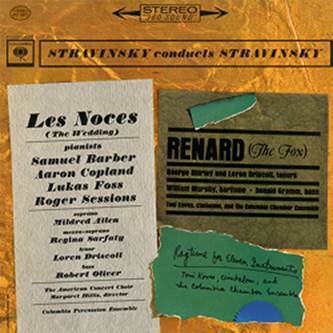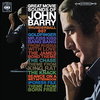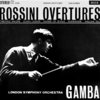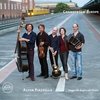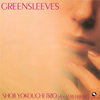AAA 100% Analogue This LP was Remastered using Pure Analogue Components Only from the Master Tapes through to the Cutting Head
Speakers Corner / Columbia - MS 6372 - 180 Gram Virgin Vinyl
AAA 100% Analogue - Mastered by Kevin Gray at Cohearant Audio
Pressed at Pallas - Limited Edition
Speakers Corner 25 Years pure Analogue
Speakers Corner has done an outstanding job on this 180-gram re-master. The vital percussion is rendered with distinct crispness in the mix. The operatic voices are centered and integrate like instruments - Audiophileaudition
Igor Stravinsky: Les Noces ("The Wedding"), Renard ("The Fox") Ragtime for Eleven Instruments - various soloists, the Columbia Chamber and Percussion Ensembles conducted by Igor Stravinsky
Although ten years separate the gigantic composition Le Sacre du Printemps and the dance cantata Les Noces, the more recent work has several things in common with its scandalous predecessor. Originally Stravinsky planned to use a vast orchestra of 150 musicians, but decided after numerous attempts to settle for four pianos, percussion, voices and mixed chorus. Concealed behind the innocuous title is not a peasant wedding but once again an archaic ritual, “which takes possession of several of the central figures, drives them on and eventually crushes them with its unrelenting movement” (André Boucourechliev, Igor Stravinski, Fayard 1982). Ballet, rhythmic dance through and through, fuses with Russian melodic song and thereby exudes a folkloristic exoticism.
Rarely performed yet zestful and a sheer delight for the ears is the burlesque tale Renard, a musical fable about Reynard the crafty Fox, the Cock, the Cat, and the Ram.
Stravinsky himself conducted this recording made with a grand line-up of America’s top composers at the piano keyboard – Samuel Barber, Lukas Foss, Aaron Copland and Roger Sessions. One certainly can’t ask for more authenticity on record than these contemporary witnesses.
gor Stravinsky began preliminary sketches for Les Noces as early as 1912, but he was busy working on The Rite of Spring and wouldn't complete the final score until 1923. It was based on folk themes and poetry, and Stravinsky would describe the ballet as a collection of "cliches and quotations of typical Russian wedding sayings." As you read the libretto, the same phrases keep repeating, much like hearing snippets of conversation from many people discussing and preparing for the wedding. If you are familiar with Carl Orff's Carmina Burana, then Les Noces will seem familiar, but certainly less melodic. Orff admitted being influenced by hearing Les Noces and modeled much of Carmina on Stravinsky's work.
Stravinsky had considered a huge orchestra for Les Noces but settled on the final orchestration of four soloists, four pianos, chorus and six percussionists. This choice of a smaller ensemble meant it would never be a sonic tour de force like his Rite or Firebird. Dedicated to Sergei Diaghilev, founder of the Ballet Russes, Les Noces was first performed in 1923 by that ensemble with Ernest Ansermet conducting. This reissue is of the 1959 Columbia recording, which has great star power: Stravinsky conducting and the four piano parts played by Samuel Barber, Aaron Copland, Lukas Foss and Roger Sessions, each a leading American composer. Stravinsky takes a more measured approach to Les Noces than Bernstein or Robert Craft, which makes his version a bit staid.
Side 2 of this LP has two seldom-performed jewels: Renard, whose performance bristles with energy and drive, followed by an enjoyable, playful reading of Ragtime for Eleven Instruments. Renard is described as a "Burlesque for Singing and Acting," telling a barnyard fable with some rather dark lyrics. The Ragtime for Eleven Instruments was composed after Stravinsky studied a collection of piano rags Ernest Ansermet brought back from America. Both of these pieces were influenced by Stravinsky's study of those scores and sound very much like his more famous L'histoire du Soldat, with punchy rhythms, angular melodic lines and bursts of virtuosic display. Also, both selections use the cimbalom, a Eastern European dulcimer with damper pedals similar to a piano. Stravinsky used the cimbalom to imitate an ancient Russian instrument, the guzla, which is a metal-stringed balalaika. He was so fond of the cimbalom that Ragtime was composed on that instrument. Unfortunately, Stravinsky decided to abandon writing for the cimbalom due to the lack of trained musicians for the instrument.
Speakers Corner has done a wonderful job at reproducing the original Columbia release's cover and the accompanying lyrics insert. It's great to see the composer and the dream team of piano soloists pictured on the album insert, along with a shot of the recording session with all of the pianos and percussionists. Soloists are clearly heard in the mix, but I would have liked more clarity from the chorus responses, as they are obscured by the instruments too often. The choir often lacks clarity and that detracts from the recording. Percussion is quite powerful and triangle is clearly reproduced, particularly in Renard. I'd also mention the fine performances of the wind players in Renard as they execute those wicked runs and flourishes.
While this recording may not be a sonic spectacular, it is enlightening to hear a mature Stravinsky's interpretation of music from his youthful and prolific period of composing. Les Noces is an influential piece of early Stravinsky writing, but it's Renard and Ragtime to which I will return.
Recording: September 1962 at American Legion Hall, Hollywood, and January 1962 at Manhatten Center, New York, by Edwin Michalski
Production: John McClure
Musicians:
Samuel Barber, piano
Aaron Copland, piano
Lukas Foss, piano
Roger Sessions, piano
Mildred Allen, soprano
Regina Sarfaty, mezzo-soprano
Loren Driscoll, tenor
Robert Oliver, bass
The American Concert Choir with Margaret Hillis as director
Selections:
Igor Stravinsky (1882-1971)
1. Les Noces (The Wedding)
2. Renard (The Fox)
3. Ragtime for Eleven Instruments

25 Years pure Analogue
This Speakers Corner LP was remastered using pure analogue components only, from the master tapes through to the cutting head
Are your records completely analogue?
Yes! This we guarantee!
As a matter of principle, only analogue masters are used, and the necessary cutting delay is also analogue. All our cutting engineers use only Neumann cutting consoles, and these too are analogue. The only exception is where a recording has been made – either partly or entirely – using digital technology, but we do not have such items in our catalogue at the present time
Are your records cut from the original masters?
In our re-releases it is our aim to faithfully reproduce the original intentions of the musicians and recording engineers which, however, could not be realised at the time due to technical limitations. Faithfulness to the original is our top priority, not the interpretation of the original: there is no such thing as a “Speakers Corner Sound”. Naturally, the best results are obtained when the original master is used. Therefore we always try to locate these and use them for cutting. Should this not be possible, – because the original tape is defective or has disappeared, for example – we do accept a first-generation copy. But this remains an absolute exception for us.
Who cuts the records?
In order to obtain the most faithful reproduction of the original, we have the lacquers cut on the spot, by engineers who, on the whole, have been dealing with such tapes for many years. Some are even cut by the very same engineer who cut the original lacquers of the first release. Over the years the following engineers have been and still are working for us: Tony Hawkins, Willem Makkee, Kevin Gray, Maarten de Boer, Scott Hull, and Ray Staff, to name but a few.
At the beginning of the ‘90s, in the early days of audiophile vinyl re-releases, the reissue policy was fairly straightforward. Companies such as DCC Compact Classics, Mobile Fidelity, Classic Records and others, including of course Speakers Corner, all maintained a mutual, unwritten code of ethics: we would manufacture records sourced only from analogue tapes.
Vinyl’s newfound popularity has led many other companies to jump on the bandwagon in the hope of securing a corner of the market. Very often they are not so ethical and use every imaginable source from which to master: CDs, LPs, digital files and even MP3s.
Even some who do use an analogue tape source employ a digital delay line, a misguided ’80s and ‘90s digital technology that replaces the analogue preview head originally used to “tell” the cutter head in advance what was about to happen musically, so it could adjust the groove “pitch” (the distance between the grooves) to make room for wide dynamic swings and large low frequency excursions. Over time analogue preview heads became more rare and thus expensive.
So while the low bit rate (less resolution than a 16 bit CD) digital delay line is less expensive and easier to use than an analogue “preview head”, its use, ironically, results in lacquers cut from the low bit rate digital signal instead of from the analogue source!
Speakers Corner wishes to make clear that it produces lacquers using only original master tapes and an entirely analogue cutting system. New metal stampers used to press records are produced from that lacquer. The only exceptions are when existing metal parts are superior to new ones that might be cut, which includes our release of “Elvis is Back”, which was cut by Stan Ricker or several titles from our Philips Classics series, where were cut in the 1990s using original master tapes by Willem Makkee at the Emil Berliner Studios. In those cases we used only the original “mother” to produce new stampers.
In addition, we admit to having one digital recording in our catalogue: Alan Parsons’ “Eye in the Sky”, which was recorded digitally but mixed to analogue tape that we used to cut lacquers.
In closing, we want to insure our loyal customers that, with but a few exceptions as noted, our releases are “AAA”— analogue tape, an all analogue cutting system, and newly cut lacquers.
PALLAS
Audiophile Vinyl - Made in Germany For over 60 years the family business in the third generation of the special personal service and quality "Made by Pallas" is known worldwide. Our custom PVC formulation produces consistently high pressing quality with the lowest surface noise in the industry. Our PVC complies with 2015 European environmental standards and does not contain toxic materials such as Lead, Cadmium or Toluene. Our vinyl is both audiophile and eco-grade!
